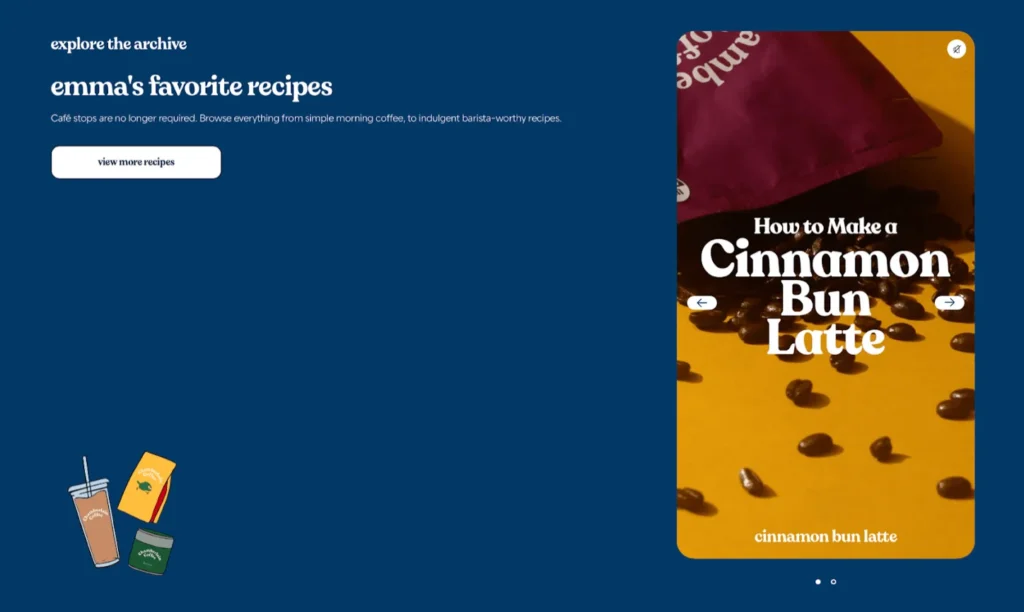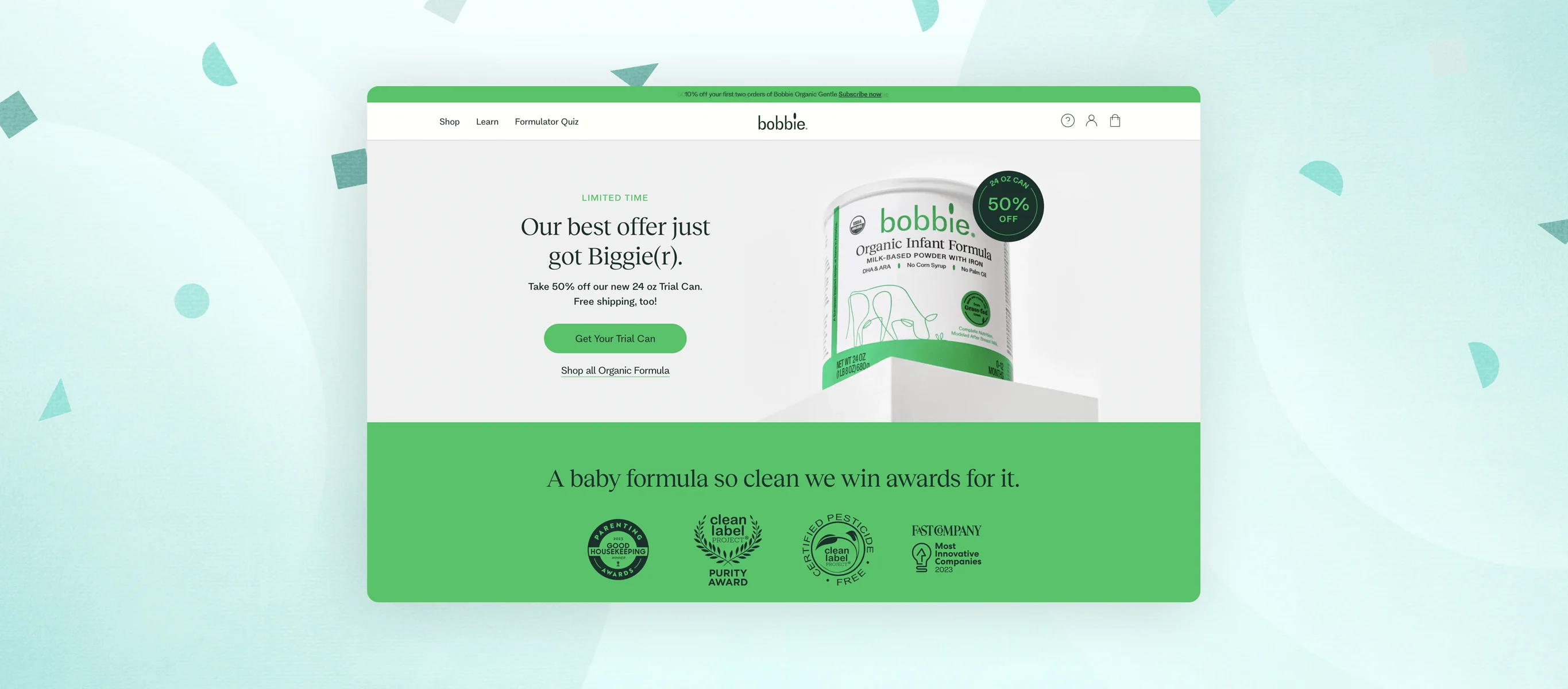Understanding direct-to-consumer (DTC) commerce is simple: Businesses sell their products or services directly to their end customers. In other words, the middleman is cut out of the chain, allowing merchants to reach their customers directly. Many businesses choose this particular business model so they have more control over the customer relationship.
To better understand the direct-to-consumer model, let’s dive into its meaning, the pros and cons of choosing DTC, plus three exceptional DTC brands to learn from as you hone your strategy.
Key takeaways
- The DTC model offers brands complete control over the customer experience, direct access to customers, and ownership of customer data—enhancing loyalty and retention.
- Bobbie, Gainful, and Chamberlain Coffee effectively use strategies like trial products, personalized quizzes, and social media to connect with customers and build loyal bases.
- To stay competitive, DTC brands are leveraging first-party and zero-party data for personalized shopping, expanding into physical retail and pop-ups, and offering premium memberships to deepen customer connections.
What does direct-to-consumer mean?
So, what is DTC? As it’s listed in our ecommerce glossary, direct-to-consumer is “an ecommerce business model where a merchant produces their own products or services and sells them directly to consumers. This differs from other business models, where third-party retailers or wholesalers can be used.” Direct-to-consumer is also known as D2C or DTC.
DTC is becoming more and more popular, especially among online stores, because it gives them a direct line to their customers. This increased interaction and control can help increase customer retention and brand loyalty—plus, the customer journey is cohesive and simple for shoppers.
Pros & cons of the direct-to-consumer model
When starting a business or online store, there are many things to consider. Deciding which business model will be most advantageous is a crucial first step. While there are many pros to the direct-to-consumer model for consumer brands, there are also a few disadvantages you’ll want to consider. Explore these pros and cons below to make the best decision for your business.
DTC advantages
For merchants looking to reach consumers directly and drive sales in a personal way, direct-to-consumer is the best business model. You can sell directly to individual consumers at competitive pricing, and meet all customer expectations thanks to this personal approach.
1. Control over the customer experience
The biggest and most well-known advantage of direct-to-consumer businesses is the control they have over just about everything in the customer journey. With DTC, brands can influence:
- Brand positioning
- Brand identity
- Product design
- Digital marketing
- Supply chain
- Shipping logistics
Unlike traditional retail, direct-to-consumer brands control every aspect of the customer experience, from how shoppers hear about their product to the ways in which they can purchase the product. Furthermore, DTC brands can utilize the data and customer feedback they collect to make the customer journey even better.
2. Direct access to customers
Brands that are able to interact directly with their customers can gain valuable insight into how their customers behave and what will be successful among their customer base. By tracking customer data and analyzing metrics, a direct-to-consumer company can help ensure the end user will be satisfied with their shopping experience—something a traditional model can’t always deliver on. When customers feel heard and seen, they will keep coming back to your brand.
3. Own customer data & information
When building a brand, it’s crucial to build relationships with customers. It’s hard to do this if you don’t have your customer’s information, such as their email address or phone number. How can you communicate with customers, or make improvements to the customer experience, if you don’t have any information about them?
For this reason, direct-to-consumer business models have a real advantage over traditional models. A common strategy brands use to capture this elusive customer data is through zero-party data collection methods like interactive quizzes.
A standout example is Apothékary. This wellness brand thrives in a competitive market by connecting personally with customers. By offering early assessments, Apothékary eases customer research and skepticism, gaining valuable insights to create personalized herbal plans.

4. Targeted marketing efforts
With all this crucial customer information and data, DTC brands can launch targeted marketing efforts. Whether utilizing email or social media marketing, knowing who your target audience is and what they look for in a brand will help you hit the mark with any marketing campaign. Stocking products with retail partners, on the other hand, means giving up control of how your product will be advertised.
Marketing strategies for DTC brands benefit from the control over all digital channels, and the access to data that traditional businesses—such as retail stores—lack.
5. Build relationships with loyal customers
When brands sell directly to the end consumer and not in retail stores, they have the chance to build a more personal relationship with their customers. One of the major advantages of DTC is this opportunity to cultivate a community of loyal customers. Interacting with consumers online and utilizing marketing tactics aimed to increase customer engagement will help your brand grow and create a stable following. Both you and your customers will benefit from this close relationship.
Using a subscription-based model can also be the difference between converting new customers to customers for life. Many DTC brands offer subscription services to give customers stability. For example, consumer packaged goods (CPG) brands—selling frequently-used replenishables like household cleaners or personal care products—offer enormous convenience and value to their customers by offering these items on subscription. This is also a great way to increase sales by creating a model with repeat payments.
6. Lower barrier to entry
Direct-to-consumer brands often face a lower barrier to entry compared to traditional retail models. Without the need for physical storefronts, DTC companies can start with a lower initial investment. This allows entrepreneurs and small businesses to launch their products online with fewer financial constraints.
Digital platforms, e-commerce websites, and social media channels make it easier and more affordable to reach a wide audience, test market demand, and scale operations quickly. This lower barrier to entry encourages innovation and allows new brands to enter the market and compete effectively, fostering a dynamic and diverse retail landscape.
In addition, it gives DTC brands the ability to pass more of those savings on to their consumers.
DTC disadvantages
Of course, as with any business model, there are going to be some challenges for those that use a DTC strategy. When deciding on which model to use, it’s crucial to understand both sides of the coin. Many of the advantages of direct-to-consumer will outweigh the disadvantages listed below.
1. Technology
If you’re going to build a DTC brand, it means you’ll need the proper tech stack to manage and run your business. The technology needed for business processes will depend on your brand and how you’d like to configure the customer experience. In order to make direct sales, you have to set up an online store that’s simple for customers to navigate, and gives you all the data and information you need on the back end.
2. Operations
Consumer brands need to have steady operations in order to keep up with customer orders, help and support tickets, shipping, and other operational factors. When selling products directly to consumers, there aren’t always retail partners to help with these logistics. For this reason, any DTC brand has to have a solid plan as to how they will operate and what roles they’ll need to fill. Much of the focus should be on acquiring new customers and retaining existing ones.
3. Processing orders
As with the operational considerations, direct-to-consumer brands will need to arrange their own product packaging, processing, and shipping. To sell products, companies have to consider the entire process—from manufacturing to packaging to shipping. Whether you sell beauty products or pet food, you will need a robust plan to get customers their products.
D2C examples: 2 brands to learn from
There are many brands crushing the direct-to-consumer game, and they can provide inspiration for those aspiring to also follow this model. The merchants listed below are all great examples of direct-to-consumer companies that have taken advantage of the benefits of this model.
Bobbie
The DTC model’s major advantage is how it lowers the barrier to entry by bypassing traditional retailers and intermediaries, allowing cost savings to be passed on to the consumer.
Bobbie, an organic infant formula brand founded by health-conscious moms, excels in this area by offering a low-cost, low-commitment method to engage new customers. Their “trial can” at 50% off allows new customers to experience the product’s quality firsthand, justifying a higher price point later

Additionally, Bobbie offers an auto-renew subscription service, keeping customers stocked with new infant formula each month and maintaining a close relationship with them.
Chamberlain Coffee
Brands like Chamberlain Coffee know how to generate buzz—if their 439,000 followers and 9.5 million likes on TikTok are any proof.
When it comes to growing your subscriber base, channels like TikTok empower brands with creative ways to showcase their products and build brand affinity. Chamberlain Coffee has capitalized on this by tapping into their founder Emma Chamberlain’s fame and massive social presence, developing valuable video content to reach and engage consumers.
In fact, according to a recent survey, 37% of TikTok users have discovered a new product on the platform, highlighting the immense potential for D2C brands to use social media to drive awareness and sales.

When considering your own DTC marketing strategy, look to Chamberlain Coffee for inspiration. Take their recipe archive for example, this is a smart way to repurpose their social content and offers new customers a chance to see their products in use
Top D2C strategies transforming ecommerce in 2024
The DTC model is one of control and freedom for merchants—with power over the customer journey, each brand can ensure they are meeting customer expectations and successfully marketing their products.
As you explore new strategies to engage consumers, consider these key areas which are gaining traction across DTC:
- Emphasis on first-party & zero-party data: With the decline of third-party cookies, DTC brands are prioritizing the collection and use of first-party data to deliver personalized shopping experiences. Tools like quizzes and customer feedback mechanisms are used to gather valuable data directly from customers.
- Physical retail expansion & pop-ups: Many digitally-native DTC brands are opening physical stores to complement their online presence. This strategy helps improve customer engagement by allowing customers to experience products in person, which can drive online sales and enhance brand loyalty. Consider exploring with smaller pop-ups to gauge interest.
- Premium membership programs: DTC brands are leveraging premium membership programs to foster customer loyalty. These programs offer exclusive benefits and personalized content, resulting in higher average order values and repeat purchase rates.
By adopting these innovative strategies, D2C brands can stay ahead of the competition and build stronger relationships with their customers.



